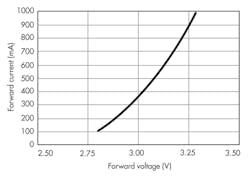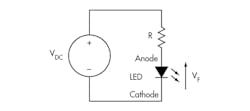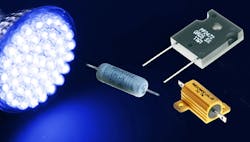Not all resistors are the same. Growth in new markets like high-power LED lighting highlights the importance of understanding all of an application’s aspects before correctly and safely specifying the right type of resistor.
For example, LEDs need to be correctly biased to achieve the optimum light output performance specified by the manufacturers. Also, driving several LEDs in series can be more efficient than overdriving single LEDs. Furthermore, keeping temperatures in check is key to maximizing output as well as to maintaining the desired color tone and ensuring reliability and long life.
Related Articles
- Fundamentals Of LED Light Pipes
- LEDs Line Up To Replace Residential Incandescent Bulbs
- LED Lighting Depends On Drivers
Having understood the biasing calculations for some typical lighting scenarios, it quickly becomes apparent that in many applications the necessary ballast resistor is likely to dissipate several watts. This not only dictates the need for a suitable high-power resistor type, it also may call for a design suitable for mounting on a heatsink to help carry heat away from the LED rather than contribute to an already challenging design requirement.
Operation And Biasing Requirements
An LED is a type of semiconductor diode that emits light when a current flows from anode to cathode across its P-N junction. Hence, in normal operation, an LED requires a dc supply to provide the necessary positive bias (forward voltage) across this junction.
High-brightness LEDs intended for lighting applications typically deliver optimum performance with a forward voltage of around 3 V. However, the relationship of voltage to current is non-linear. While the LED will start to turn on at a lower voltage, it will rapidly draw a much higher current as the voltage increases above its nominal rating (Fig. 1).
Apart from considerations of heat dissipation and reliability, this is inefficient since the relationship of luminous flux (a measure of light output) with LED current is also non-linear. A doubling of current, then, certainly does not result in twice the light output. A far better solution to achieve the desired light output is to use multiple LEDs.
Given these characteristics, the conventional solution for driving LEDs is to control the current through the device (Fig. 2).
The simplest method employs a series resistor to limit current so, using Ohm’s Law:
IF = (VDC – VF)/R
where:
IF = forward current
VDC = supply voltage
VF = forward voltage
R = ballast resistor
It is possible to use a rectified and smoothed mains input to power the LED bias circuit, but the resulting supply voltage will be much higher than the forward voltage across a single LED, meaning that considerable power would be wasted in the ballast resistor compared to the power consumed by the LED. Connecting a number of LEDs in series, which is typical of many LED lamp designs, only partially addresses the issue, as the cumulative forward voltage will still be less that the voltage dropped across the resistor.
Instead, most LED lighting systems employ power supply units (PSUs) with dedicated LED driver circuits providing an output to suit the required LED configuration. These PSUs typically accept ac mains input with a dc output that may drive a single LED but more likely a string of LEDs operating at voltages up to 60 V.
Even the “60-W replacement” type of LED bulb uses a built-in LED driver circuit to convert ac mains to a suitable dc voltage to power its LEDs. Dedicated power supplies also allow the connection of LEDs or LED strings in parallel for distributed lighting systems, but normally the current in each parallel path still needs to be limited by a separate series resistor.
Ballast Resistors
We can most readily understand this by performing some simple calculations based on the bias circuit and LED characteristics shown above. For example, using a 24-V dc supply and six LEDs connected in series (each with a nominal forward voltage of 3 V) leaves us with 6 V to be dropped across the ballast resistor. So with a corresponding LED forward current of 350 mA, the required resistor value is:
R = (VDC – 6 x VF)/IF = (24 – 6 x 3)/0.35 = 17.1 Ω
And, the power that the resistor has to dissipate is:
P = V x I = 6 x 0.35 = 2.1 W
This provides the baseline specification for the resistor. But before moving on to see what type of resistor might be suitable, it is perhaps useful to question some of our assumptions—such as, why a 24-V supply when clearly a 20-V supply would reduce the power dissipation in the resistor to just 0.7 W? One reason lies with design and component tolerances.
A typical PSU may have an output voltage tolerance of ±5%. While the current/voltage characteristic of the LEDs is still a factor, most of the output variation will affect the voltage across the resistor. Hence in our example with a 24-V PSU, an increase of +5% (+1.2 V) will result in a current increase to around 400 mA, which is still close to nominal for the LEDs. But with a 20-V PSU, a +5% increase (+1 V) takes the forward current to around 450 mA, which is disproportionally higher than the target 350 mA.
Similar effects on the forward current will result if the resistor value itself deviates significantly from the design target value or if the LEDs vary from their nominal characteristics. Although there are no absolute rules for the design of LED bias circuits, all these factors need to be addressed.
The penalty, as noted earlier, is that the increased power dissipation from operating at higher currents leads to higher LED junction temperatures. This results in reduced relative light output, which partly negates any increase from operating at a higher current, but more importantly influences the device’s reliability and expected lifetime.
Variations in current and temperature also affect the relative chromaticity, or color tone, of an LED, which is another reason for keeping both under control. This raises the issue of LED dimming since, although it is possible to achieve analog dimming of LEDs over a limited brightness range by varying the drive current, sometimes even beyond its nominal rating, this comes with the same problem of color variations.
Instead, the preferred method is pulse-width modulation (PWM) of the bias current. This approach typically drives the LEDs with a rectangular waveform, effectively switching the LEDs on and off at a rate (100 kHz or more) that is too high to be noticed.
This way, the LEDs see the ideal nominal forward current during the “on” part of the cycle and there is negligible power dissipation during the “off” phase. The potential requirement for PWM dimming does, however, impose another constraint on the choice of ballast resistor—namely that it needs to be a non-reactive load, i.e., with minimal inductance or capacitance.
Resistors For LED Ballasts
Devices with a nominal rated forward current of 350 mA are quite typical for LED lighting applications, but LEDs designed for operation at 700 mA, 1 A, and even 1.5 A are becoming increasingly common. So where the above application example requires a resistor with a rating just over 2 W, higher-power LEDs may well require resistors rated at 10 W or more.
Axial-leaded wirewound resistors offer reasonable power handling with low resistance tolerances and excellent low temperature coefficient of resistance (TCR) performance. They also can operate over a wide temperature range.
Riedon’s UT series wirewound power resistor offers power ratings up to 13 W and a temperature range of –55oC to 250oC (or even 350oC for some types). For even higher power dissipation, or where it is important to remove heat more effectively from the ballast resistor, Riedon’s UAL series of aluminum-housed wirewound power resistors offers ratings to 50 W and above.
Wirewound resistors are available with non-inductive windings, but thin-film resistor technology provides an alternative that may suit some applications. Riedon’s PF series offers low-inductance power film resistors in various package housings to support different power ratings such as 20-W TO-126 and 50-W TO-220. For surface-mount designs, Rideon’s PFS series of power surface-mount device (SMD) film resistors can handle up to 35 W.
Phil Ebbert, vice president of engineering, is in charge of resistor development at Riedon Inc. He is also responsible for its technology projects, including equipment, testing, and process design. He has 15 years resistor engineering experience and led Riedon’s expansion from wirewound resistors into related film and foil technologies. He studied physics, optics, and computer science at Carnegie Mellon University.
About the Author
Phil Ebbert
Vice President of Engineering
Phil Ebbert, vice president of engineering, is in charge of resistor development at Riedon Inc. He is also responsible for its technology projects, including equipment, testing, and process design. He has 15 years resistor engineering experience and led Riedon’s expansion from wirewound resistors into related film and foil technologies. He studied physics, optics, and computer science at Carnegie Mellon University.



